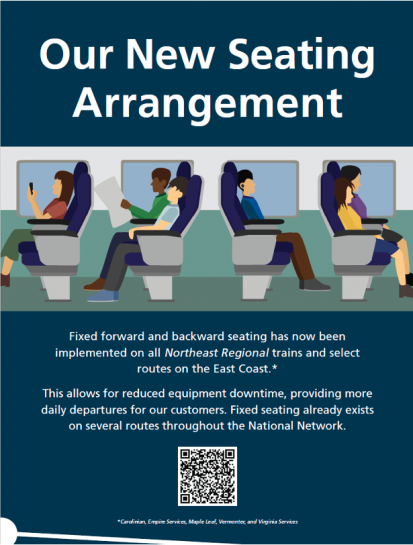Happening Now
Fixed Seats Come to the Northeast Corridor
March 1, 2024
By Jim Mathews / President & CEO
Starting tomorrow, Northeast Corridor trains will begin transitioning to “fixed seating” – in other words, half of each car will have seats facing forward, while the other half will face the rear. The Northeast Regional trains, plus the Carolinian, Empire Service, Vermonter, and Amtrak Virginia, will all make the change.
In a “fact sheet” release to the press this week, Amtrak explained rather blandly that “this arrangement enhances services for customers on the NEC with more frequencies by reducing the time required in between trips.”
To my mind they’re really not taking enough credit here; we think this is a creative and clever way to add significant capacity to a heavily used service while sidestepping the towering ten-year backlogs for new equipment we now face in the U.S. – backlogs which are significant obstacles to our realizing any near-term service gains anywhere.
On its face, it’s simple enough. If you leave the seats in place in this configuration at the endpoint stations, crews no longer need to spend the time and effort swapping the seats to face the direction of travel. This effort is not trivial. To do this work now crews must wye the trains in New York and Washington, which takes about three hours each time. With the new procedure, trains can stay on the platform to be prepped for departure – which means fewer yard moves, and less time deadheading between the station and mechanical facilities. The train can be turned and ready to go in one hour!
Saving that much time lets Amtrak add four more round trips on the Northeast Corridor between New York and DC on most days – eight one-way frequencies – along with two more Sunday round trips. Adding that many trains will mean as many as 3,500 seats per day added to the NEC’s capacity, helping to relieve peak congestion and even creating some room to lower fares.
In other words, just like a scrappy baseball team finding ways to “manufacture” runs without a big power hitter, Amtrak managed to manufacture a 16 percent increase in the number of departures without having to buy and put in service the trains you would need otherwise to operate it. Think about it: you could try to buy and introduce 24 new train cars, waiting many years for it to happen...or just change what you’re doing today to do it more smartly and create the same number of seats for sale.

This is a major change for Northeast Corridor regulars, and some folks will grumble about sitting backwards. (Full disclosure: my wife hates sitting backwards, and I’ve already been told that I will be switching seats to accommodate her preference!) Amtrak did its homework and found that only about 10 percent of passengers would have a genuine problem with motion sickness from sitting backwards. This week executives told us that they acknowledge that even though it’s a relatively small number of passengers, it’s a significant enough number that they have tried to develop ways to anticipate the needs of those riders.
Conductors have already been trained on how to try to accommodate those passengers who really need employees’ best efforts to move seats. My advice to those passengers is to arrive as early as you can at your departure station and ask a conductor whether they can put you in a forward-facing seat, either in the car you’re already in or, perhaps, in another car where a forward-facing seat is available. The other option is to book Business Class, which permits passengers to choose their seats.
Eventually the entire Northeast Corridor inventory will have seats passengers can choose at booking, but for now the reservation system simply can’t handle it.
While this is a Big Deal ™ on the Northeast Corridor, it’s business-as-usual elsewhere within the Amtrak network. This seating arrangement is old hat for folks who regularly ride the Cascades, the Downeaster, the Ethan Allen, the Keystone service, the Hiawatha, the Illini and Saluki, the River Runner, the Springfield Shuttles, and the Wolverine.
Even so, Amtrak recognizes that it will take some getting used to on its busiest patch between New York and Washington. They’ve trained and briefed frontline employees like ticket agents, conductors, and call-takers in the reservations center, and spent a lot of time briefing stakeholders like State partners who pay for these trains in Virginia and North Carolina, as well as us. We met with Amtrak managers on Monday to get the details on what was coming.
In my view, Amtrak deserves a pat on the back for developing a creative and even elegant solution to a capacity problem, a solution that can be implemented right away and which will save everyone – the railroad and passengers alike – money, time, and hassle. Obviously, the real answer in the long run is enough new equipment to operate more frequencies everywhere Amtrak trains run and that’s something we’re also pressing hard to make happen more quickly. But who wants to wait years or even a decade when a little creativity can mean real progress in the meantime? I’ll take this win. Well-done, Amtrak!
"The support from the Rail Passengers Association, and from all of you individually, has been incredibly important to Amtrak throughout our history and especially so during the last trying year."
Bill Flynn, Amtrak CEO
April 19, 2021, speaking to attendees at the Rail Passengers Virtual Spring Advocacy Conference
Comments